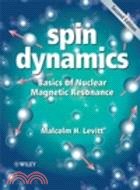Spin Dynamics - Basics Of Nuclear Magnetic Resonance 2E
商品資訊
ISBN13:9780470511176
出版社:John Wiley & Sons Inc
作者:Levitt
出版日:2008/03/07
裝訂/頁數:平裝/744頁
規格:24.8cm*19.7cm*3.8cm (高/寬/厚)
商品簡介
目次
相關商品
商品簡介
Spin Dynamics: Basics of Nuclear Magnetic Resonance, Second Edition is a comprehensive and modern introduction which focuses on those essential principles and concepts needed for a thorough understanding of the subject, rather than the practical aspects. The quantum theory of nuclear magnets is presented within a strong physical framework, supported by figures.
The book assumes only a basic knowledge of complex numbers and matrices, and provides the reader with numerous worked examples and exercises to encourage understanding. With the explicit aim of carefully developing the subject from the beginning, the text starts with coverage of quarks and nucleons and progresses through to a detailed explanation of several important NMR experiments, including NMR imaging, COSY, NOESY and TROSY.
Completely revised and updated, the Second Edition features new material on the properties and distributions of isotopes, chemical shift anisotropy and quadrupolar interactions, Pake patterns, spin echoes, slice selection in NMR imaging, and a complete new chapter on the NMR spectroscopy of quadrupolar nuclei. New appendices have been included on Euler angles, and coherence selection by field gradients. As in the first edition, all material is heavily supported by graphics, much of which is new to this edition.
Written for undergraduates and postgraduate students taking a first course in NMR spectroscopy and for those needing an up-to-date account of the subject, this multi-disciplinary book will appeal to chemical, physical, material, life, medical, earth and environmental scientists. The detailed physical insights will also make the book of interest for experienced spectroscopists and NMR researchers.
‧ An accessible and carefully written introduction, designed to help students to fully understand this complex and dynamic subject
‧ Takes a multi-disciplinary approach, focusing on basic principles and concepts rather than the more practical aspects
‧ Presents a strong pedagogical approach throughout, with emphasis placed on individual spins to aid understanding
‧ Includes numerous worked examples, problems, further reading and additional notes
Praise from the reviews of the First Edition:
"This is an excellent book... that many teachers of NMR spectroscopy will cherish... It deserves to be a 'classic' among NMR spectroscopy texts." NMR IN BIOMEDICINE
"I strongly recommend this book to everyone…it is probably the best modern comprehensive description of the subject." ANGEWANDTE CHEMIE, INTERNATIONAL EDITION
The book assumes only a basic knowledge of complex numbers and matrices, and provides the reader with numerous worked examples and exercises to encourage understanding. With the explicit aim of carefully developing the subject from the beginning, the text starts with coverage of quarks and nucleons and progresses through to a detailed explanation of several important NMR experiments, including NMR imaging, COSY, NOESY and TROSY.
Completely revised and updated, the Second Edition features new material on the properties and distributions of isotopes, chemical shift anisotropy and quadrupolar interactions, Pake patterns, spin echoes, slice selection in NMR imaging, and a complete new chapter on the NMR spectroscopy of quadrupolar nuclei. New appendices have been included on Euler angles, and coherence selection by field gradients. As in the first edition, all material is heavily supported by graphics, much of which is new to this edition.
Written for undergraduates and postgraduate students taking a first course in NMR spectroscopy and for those needing an up-to-date account of the subject, this multi-disciplinary book will appeal to chemical, physical, material, life, medical, earth and environmental scientists. The detailed physical insights will also make the book of interest for experienced spectroscopists and NMR researchers.
‧ An accessible and carefully written introduction, designed to help students to fully understand this complex and dynamic subject
‧ Takes a multi-disciplinary approach, focusing on basic principles and concepts rather than the more practical aspects
‧ Presents a strong pedagogical approach throughout, with emphasis placed on individual spins to aid understanding
‧ Includes numerous worked examples, problems, further reading and additional notes
Praise from the reviews of the First Edition:
"This is an excellent book... that many teachers of NMR spectroscopy will cherish... It deserves to be a 'classic' among NMR spectroscopy texts." NMR IN BIOMEDICINE
"I strongly recommend this book to everyone…it is probably the best modern comprehensive description of the subject." ANGEWANDTE CHEMIE, INTERNATIONAL EDITION
目次
Preface.
Preface to the First Edition.
Introduction.
Part 1 Nuclear Magnetism.
1 Matter.
1.1 Atoms and Nuclei.
1.2 Spin.
1.3 Nuclei.
1.4 Nuclear Spin.
1.5 Atomic and Molecular Structure.
1.6 States of Matter.
Notes.
Further Reading.
Exercises.
2 Magnetism.
2.1 The Electromagnetic Field.
2.2 Macroscopic Magnetism.
2.3 Microscopic Magnetism.
2.4 Spin Precession.
2.5 Larmor Frequency.
2.6 Spin-Lattice Relaxation: Nuclear Paramagnetism.
2.7 Transverse Magnetization and Transverse Relaxation.
2.8 NMR Signal.
2.9 Electronic Magnetism.
Notes.
Further Reading.
Exercises.
3 NMR Spectroscopy.
3.1 A Simple Pulse Sequence.
3.2 A Simple Spectrum.
3.4 Relative Spectral Frequencies: Case of Positive
Gyromagnetic Ratio.
3.5 Relative Spectral Frequencies: Case of Negative Gyromagnetic Ratio.
3.6 Inhomogeneous Broadening.
3.7 Chemical Shifts.
3.8 J-Coupling Multiplets.
3.9 Heteronuclear Decoupling.
Notes.
Further Reading.
Exercises.
Part 2 The NMR Experiment.
4 The NMR Spectrometer.
4.1 The Magnet.
4.2 The Transmitter Section.
4.3 The Duplexer.
4.4 The Probe.
4.5 The Receiver Section.
4.6 Overview of the Radio-Frequency Section.
4.7 Pulsed Field Gradients.
Notes.
Further Reading.
5 Fourier Transform NMR.
5.1 A Single-Pulse Experiment.
5.2 Signal Averaging.
5.3 Multiple-Pulse Experiments: Phase Cycling.
5.4 Heteronuclear Experiments.
5.5 Pulsed Field Gradient Sequences.
5.6 Arrayed Experiments.
5.7 NMR Signal.
5.8 NMR Spectrum.
5.9 Two-Dimensional Spectroscopy.
5.10 Three-Dimensional Spectroscopy.
Part 3 Quantum Mechanics.
6 Mathematical Techniques.
6.1 Functions.
6.2 Operators.
6.3 Eigenfunctions, Eigenvalues and Eigenvectors.
6.4 Diagonalization.
6.5 Exponential Operators.
6.6 Cyclic Commutation.
Notes.
Further Reading.
Exercises.
7 Review of Quantum Mechanics.
7.1 Spinless Quantum Mechanics.
7.2 Energy Levels.
7.3 Natural Units.
7.4 Superposition States and Stationary States.
7.5 Conservation Laws.
7.6 Angular Momentum.
7.7 Spin.
7.8 Spin-1/2.
7.9 Higher Spin.
Notes.
Further Reading.
Exercises.
Part 4 Nuclear Spin Interactions.
8 Nuclear Spin Hamiltonian.
8.1 Spin Hamiltonian Hypothesis.
8.2 Electromagnetic Interactions.
8.3 External and Internal Spin Interactions.
8.4 External Magnetic Fields.
8.5 Internal Spin Hamiltonian.
8.6 Motional Averaging.
Notes.
Further Reading.
Exercises.
9 Internal Spin Interactions.
9.1 Chemical Shift.
9.2 Electric Quadrupole Coupling.
9.3 Direct Dipole-Dipole Coupling.
9.4 J-Coupling.
9.5 Spin-Rotation Interaction.
9.6 Summary of the Spin Hamiltonian Terms.
Notes.
Further Reading.
Exercises.
Part 5 Uncoupled Spins.
10 Single Spin-1/2.
10.1 Zeeman Eigenstates.
10.2 Measurement of Angular Momentum: Quantum Indeterminacy.
10.3 Energy Levels.
10.4 Superposition States.
10.5 Spin Precession.
10.6 Rotating Frame.
10.7 Precession in the Rotating Frame.
10.8 Radio-Frequency Pulse.
Notes.
Further Reading.
Exercises.
11 Ensemble of Spins-1/2.
11.1 Spin Density Operator.
11.2 Populations and Coherences.
11.3 Thermal Equilibrium.
11.4 Rotating-Frame Density Operator.
11.5 Magnetization Vector.
11.6 Strong Radio-Frequency Pulse.
11.7 Free Precession Without Relaxation.
11.8 Operator Transformations.
11.9 Free Evolution with Relaxation.
11.10 Magnetization Vector Trajectories.
11.11 NMR Signal and NMR Spectrum.
11.12 Single-Pulse Spectra.
Notes.
Further Reading.
Exercises.
12 Experiments on Non-Interacting Spins-1/2.
12.1 Inversion Recovery: Measurement of T1.
12.2 Spin Echoes: Measurement of T2.
12.3 Spin Locking: Measurement of T1ˆ.
12.4 Gradient Echoes.
12.5 Slice Selection.
12.6 NMR Imaging.
Notes.
Further Reading.
Exercises.
13 Quadrupolar Nuclei.
13.1 Spin I = 1.
13.2 Spin I = 3/2.
13.3 Spin I = 5/2.
13.4 Spins I = 7/2.
13.5 Spins I = 9/2.
Notes.
Further Reading.
Exercises.
Part 6 Coupled Spins.
14 Spin-1/2 Pairs.
14.1 Coupling Regimes.
14.2 Zeeman Product States and Superposition States.
14.3 Spin-Pair Hamiltonian.
14.4 Pairs of Magnetically Equivalent Spins.
14.5 Weakly Coupled Spin Pairs.
Notes.
Further Reading.
Exercises.
15 Homonuclear AX System.
15.1 Eigenstates and Energy Levels.
15.2 Density Operator.
15.3 Rotating Frame.
15.4 Free Evolution.
15.5 Spectrum of the AX System: Spin-Spin Splitting.
15.6 Product Operators.
15.7 Thermal Equilibrium.
15.8 Radio-Frequency Pulses.
15.9 Free Evolution of the Product Operators.
15.10 Spin Echo Sandwich.
Notes.
Further Reading.
Exercises.
16 Experiments on AX Systems.
16.1 COSY.
16.2 INADEQUATE.
16.3 INEPT.
16.4 Residual Dipolar Couplings.
Notes.
Further Reading.
Exercises.
17 Many-Spin Systems.
17.1 Molecular Spin System.
17.2 Spin Ensemble.
17.3 Motionally Suppressed J-Couplings.
17.4 Chemical Equivalence.
17.5 Magnetic Equivalence.
17.6 Weak Coupling.
17.7 Heteronuclear Spin Systems.
17.8 Alphabet Notation.
17.9 Spin Coupling Topologies.
Notes.
Further Reading.
Exercises.
18 Many-Spin Dynamics.
18.1 Spin Hamiltonian.
18.2 Energy Eigenstates.
18.3 Superposition States.
18.4 Spin Density Operator.
18.5 Populations and Coherences.
18.6 NMR Spectra.
18.7 Many-Spin Product Operators.
18.8 Thermal Equilibrium.
18.9 Radio-Frequency Pulses.
18.10 Free Precession.
18.11 Spin Echo Sandwiches.
18.12 INEPT in an I2S System.
18.13 COSY in Multiple-Spin Systems.
18.14 TOCSY.
Notes.
Further Reading
Exercises.
Part 7 Motion and Relaxation.
19 Motion.
19.1 Motional Processes.
19.2 Motional Time-Scales.
19.3 Motional Effects.
19.4 Motional Averaging.
19.5 Motional Lineshapes and Two-Site Exchange.
19.6 Sample Spinning.
19.7 Longitudinal Magnetization Exchange.
19.8 Diffusion.
Notes.
Further Reading.
Exercises.
20 Relaxation.
20.1 Types of Relaxation.
20.2 Relaxation Mechanisms.
20.3 Random Field Relaxation.
20.4 Dipole-Dipole Relaxation.
20.5 Steady-State Nuclear Overhauser Effect.
20.6 NOESY.
20.7 ROESY.
20.8 Cross-Correlated Relaxation.
Notes.
Further Reading.
Exercises.
Appendices.
Appendix A.
A.1 Euler Angles and Frame Transformations.
A.2 Rotations and Cyclic Commutation.
A.3 Rotation Sandwiches.
A.4 Spin-1/2 Rotation Operators.
A.5 Quadrature Detection and Spin Coherences.
A.6 Secular Approximation.
A.7 Quadrupolar Interaction.
A.8 Strong Coupling.
A.9 J-Couplings and Magnetic Equivalence.
A.10 Spin Echo Sandwiches.
A.11 Phase Cycling.
A.12 Coherence Selection by Pulsed Field Gradients.
A.13 Bloch Equations.
A.14 Chemical Exchange.
A.15 Solomon Equations.
A.16 Cross-Relaxation Dynamics.
Notes.
Further Reading.
Appendix B.
B.1 Symbols and Abbreviations.
B.2 Answers to the Exercises.
Preface to the First Edition.
Introduction.
Part 1 Nuclear Magnetism.
1 Matter.
1.1 Atoms and Nuclei.
1.2 Spin.
1.3 Nuclei.
1.4 Nuclear Spin.
1.5 Atomic and Molecular Structure.
1.6 States of Matter.
Notes.
Further Reading.
Exercises.
2 Magnetism.
2.1 The Electromagnetic Field.
2.2 Macroscopic Magnetism.
2.3 Microscopic Magnetism.
2.4 Spin Precession.
2.5 Larmor Frequency.
2.6 Spin-Lattice Relaxation: Nuclear Paramagnetism.
2.7 Transverse Magnetization and Transverse Relaxation.
2.8 NMR Signal.
2.9 Electronic Magnetism.
Notes.
Further Reading.
Exercises.
3 NMR Spectroscopy.
3.1 A Simple Pulse Sequence.
3.2 A Simple Spectrum.
3.4 Relative Spectral Frequencies: Case of Positive
Gyromagnetic Ratio.
3.5 Relative Spectral Frequencies: Case of Negative Gyromagnetic Ratio.
3.6 Inhomogeneous Broadening.
3.7 Chemical Shifts.
3.8 J-Coupling Multiplets.
3.9 Heteronuclear Decoupling.
Notes.
Further Reading.
Exercises.
Part 2 The NMR Experiment.
4 The NMR Spectrometer.
4.1 The Magnet.
4.2 The Transmitter Section.
4.3 The Duplexer.
4.4 The Probe.
4.5 The Receiver Section.
4.6 Overview of the Radio-Frequency Section.
4.7 Pulsed Field Gradients.
Notes.
Further Reading.
5 Fourier Transform NMR.
5.1 A Single-Pulse Experiment.
5.2 Signal Averaging.
5.3 Multiple-Pulse Experiments: Phase Cycling.
5.4 Heteronuclear Experiments.
5.5 Pulsed Field Gradient Sequences.
5.6 Arrayed Experiments.
5.7 NMR Signal.
5.8 NMR Spectrum.
5.9 Two-Dimensional Spectroscopy.
5.10 Three-Dimensional Spectroscopy.
Part 3 Quantum Mechanics.
6 Mathematical Techniques.
6.1 Functions.
6.2 Operators.
6.3 Eigenfunctions, Eigenvalues and Eigenvectors.
6.4 Diagonalization.
6.5 Exponential Operators.
6.6 Cyclic Commutation.
Notes.
Further Reading.
Exercises.
7 Review of Quantum Mechanics.
7.1 Spinless Quantum Mechanics.
7.2 Energy Levels.
7.3 Natural Units.
7.4 Superposition States and Stationary States.
7.5 Conservation Laws.
7.6 Angular Momentum.
7.7 Spin.
7.8 Spin-1/2.
7.9 Higher Spin.
Notes.
Further Reading.
Exercises.
Part 4 Nuclear Spin Interactions.
8 Nuclear Spin Hamiltonian.
8.1 Spin Hamiltonian Hypothesis.
8.2 Electromagnetic Interactions.
8.3 External and Internal Spin Interactions.
8.4 External Magnetic Fields.
8.5 Internal Spin Hamiltonian.
8.6 Motional Averaging.
Notes.
Further Reading.
Exercises.
9 Internal Spin Interactions.
9.1 Chemical Shift.
9.2 Electric Quadrupole Coupling.
9.3 Direct Dipole-Dipole Coupling.
9.4 J-Coupling.
9.5 Spin-Rotation Interaction.
9.6 Summary of the Spin Hamiltonian Terms.
Notes.
Further Reading.
Exercises.
Part 5 Uncoupled Spins.
10 Single Spin-1/2.
10.1 Zeeman Eigenstates.
10.2 Measurement of Angular Momentum: Quantum Indeterminacy.
10.3 Energy Levels.
10.4 Superposition States.
10.5 Spin Precession.
10.6 Rotating Frame.
10.7 Precession in the Rotating Frame.
10.8 Radio-Frequency Pulse.
Notes.
Further Reading.
Exercises.
11 Ensemble of Spins-1/2.
11.1 Spin Density Operator.
11.2 Populations and Coherences.
11.3 Thermal Equilibrium.
11.4 Rotating-Frame Density Operator.
11.5 Magnetization Vector.
11.6 Strong Radio-Frequency Pulse.
11.7 Free Precession Without Relaxation.
11.8 Operator Transformations.
11.9 Free Evolution with Relaxation.
11.10 Magnetization Vector Trajectories.
11.11 NMR Signal and NMR Spectrum.
11.12 Single-Pulse Spectra.
Notes.
Further Reading.
Exercises.
12 Experiments on Non-Interacting Spins-1/2.
12.1 Inversion Recovery: Measurement of T1.
12.2 Spin Echoes: Measurement of T2.
12.3 Spin Locking: Measurement of T1ˆ.
12.4 Gradient Echoes.
12.5 Slice Selection.
12.6 NMR Imaging.
Notes.
Further Reading.
Exercises.
13 Quadrupolar Nuclei.
13.1 Spin I = 1.
13.2 Spin I = 3/2.
13.3 Spin I = 5/2.
13.4 Spins I = 7/2.
13.5 Spins I = 9/2.
Notes.
Further Reading.
Exercises.
Part 6 Coupled Spins.
14 Spin-1/2 Pairs.
14.1 Coupling Regimes.
14.2 Zeeman Product States and Superposition States.
14.3 Spin-Pair Hamiltonian.
14.4 Pairs of Magnetically Equivalent Spins.
14.5 Weakly Coupled Spin Pairs.
Notes.
Further Reading.
Exercises.
15 Homonuclear AX System.
15.1 Eigenstates and Energy Levels.
15.2 Density Operator.
15.3 Rotating Frame.
15.4 Free Evolution.
15.5 Spectrum of the AX System: Spin-Spin Splitting.
15.6 Product Operators.
15.7 Thermal Equilibrium.
15.8 Radio-Frequency Pulses.
15.9 Free Evolution of the Product Operators.
15.10 Spin Echo Sandwich.
Notes.
Further Reading.
Exercises.
16 Experiments on AX Systems.
16.1 COSY.
16.2 INADEQUATE.
16.3 INEPT.
16.4 Residual Dipolar Couplings.
Notes.
Further Reading.
Exercises.
17 Many-Spin Systems.
17.1 Molecular Spin System.
17.2 Spin Ensemble.
17.3 Motionally Suppressed J-Couplings.
17.4 Chemical Equivalence.
17.5 Magnetic Equivalence.
17.6 Weak Coupling.
17.7 Heteronuclear Spin Systems.
17.8 Alphabet Notation.
17.9 Spin Coupling Topologies.
Notes.
Further Reading.
Exercises.
18 Many-Spin Dynamics.
18.1 Spin Hamiltonian.
18.2 Energy Eigenstates.
18.3 Superposition States.
18.4 Spin Density Operator.
18.5 Populations and Coherences.
18.6 NMR Spectra.
18.7 Many-Spin Product Operators.
18.8 Thermal Equilibrium.
18.9 Radio-Frequency Pulses.
18.10 Free Precession.
18.11 Spin Echo Sandwiches.
18.12 INEPT in an I2S System.
18.13 COSY in Multiple-Spin Systems.
18.14 TOCSY.
Notes.
Further Reading
Exercises.
Part 7 Motion and Relaxation.
19 Motion.
19.1 Motional Processes.
19.2 Motional Time-Scales.
19.3 Motional Effects.
19.4 Motional Averaging.
19.5 Motional Lineshapes and Two-Site Exchange.
19.6 Sample Spinning.
19.7 Longitudinal Magnetization Exchange.
19.8 Diffusion.
Notes.
Further Reading.
Exercises.
20 Relaxation.
20.1 Types of Relaxation.
20.2 Relaxation Mechanisms.
20.3 Random Field Relaxation.
20.4 Dipole-Dipole Relaxation.
20.5 Steady-State Nuclear Overhauser Effect.
20.6 NOESY.
20.7 ROESY.
20.8 Cross-Correlated Relaxation.
Notes.
Further Reading.
Exercises.
Appendices.
Appendix A.
A.1 Euler Angles and Frame Transformations.
A.2 Rotations and Cyclic Commutation.
A.3 Rotation Sandwiches.
A.4 Spin-1/2 Rotation Operators.
A.5 Quadrature Detection and Spin Coherences.
A.6 Secular Approximation.
A.7 Quadrupolar Interaction.
A.8 Strong Coupling.
A.9 J-Couplings and Magnetic Equivalence.
A.10 Spin Echo Sandwiches.
A.11 Phase Cycling.
A.12 Coherence Selection by Pulsed Field Gradients.
A.13 Bloch Equations.
A.14 Chemical Exchange.
A.15 Solomon Equations.
A.16 Cross-Relaxation Dynamics.
Notes.
Further Reading.
Appendix B.
B.1 Symbols and Abbreviations.
B.2 Answers to the Exercises.
主題書展
更多
主題書展
更多書展今日66折
您曾經瀏覽過的商品
購物須知
外文書商品之書封,為出版社提供之樣本。實際出貨商品,以出版社所提供之現有版本為主。部份書籍,因出版社供應狀況特殊,匯率將依實際狀況做調整。
無庫存之商品,在您完成訂單程序之後,將以空運的方式為你下單調貨。為了縮短等待的時間,建議您將外文書與其他商品分開下單,以獲得最快的取貨速度,平均調貨時間為1~2個月。
為了保護您的權益,「三民網路書店」提供會員七日商品鑑賞期(收到商品為起始日)。
若要辦理退貨,請在商品鑑賞期內寄回,且商品必須是全新狀態與完整包裝(商品、附件、發票、隨貨贈品等)否則恕不接受退貨。
























